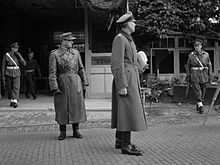Paul Reichelt

Paul Reichelt (born March 29, 1898 in Neusalza , † July 15, 1981 in Munich ) was a German officer , most recently lieutenant general in the Wehrmacht and major general in the Bundeswehr .
Life
Reichelt served as a volunteer in the Royal Saxon Army during World War I and was accepted into the Reichswehr at the end of the war .
From 1938 to the end of 1941 he was in the rank of Lieutenant Colonel General Staff Officer (Ia) of the 7th Infantry Division . He then took over the post of Chief of the General Staff at the IX until August 1943 . Army Corps . In the same function he was then also until December 1943 at the XII. Army Corps . In March 1942 he had already been promoted to colonel . He was then until March 13, 1944 as a representative of Ralph Graf von Oriola commander of the 299th Infantry Division . From November 11, 1944 to April 7, 1945 he was Chief of the General Staff of the 25th Army in Holland until the restructuring . On April 20, 1945 he was promoted to lieutenant general and had previously been appointed chief of the general staff of the Narva army department. At the end of the war he went into English captivity . After his release he worked in the Labor Service . On March 1, 1957, he was accepted into the German Armed Forces as major general.
Reichelt was in command of the 1st Panzer Division in Hanover from April 1, 1957 to March 31, 1959 . He then became a stage manager of the grenadiers in the army troop office. From October 1959 to the end of March 1962, he was the successor to Brigadier General Friedrich Übelhack, Commander of Military District Command VI in Munich . Then he retired .
Awards (selection)
- Iron Cross (1914) 2nd class
- Wound badge (1918) in black
- Clasp for the Iron Cross, 2nd class
- Iron Cross (1939) 1st class
- German cross in gold on April 25, 1942
- Knight's Cross of the Iron Cross on October 8, 1944
- Great Order of Merit of the Federal Republic of Germany
- Bavarian Order of Merit
Individual evidence
- ^ A b c d Hans-Jürgen von (ed) Arnim: German Soldier Yearbook . Schild Verlag, 1982, p. 451 ( google.de [accessed on March 8, 2020]).
- ↑ a b c Germany (East) Committee for German Unity, Germany (East) Ministry of National Defense: German arsonists at work again: a documentation on the militarization of West Germany based on materials from the Committee for German Unity . Publishing house of the Ministry of National Defense, 1959, p. 110 ( google.de [accessed on March 8, 2020]).
- ↑ a b Germany German Reich Wehrmacht High Command: War diary of the High Command of the Wehrmacht: 1942: with Nachtr. / Initiated a. ext. by Percy Ernst Schramm . Part II. Pawlak, 1982, ISBN 978-3-88199-073-8 , pp. 1459 ( google.de [accessed on March 8, 2020]).
- ^ Samuel W. Mitcham: German Order of Battle: 291st-999th Infantry divisions, named infantry divisions, and special divisions in World War II . In: German Order of Battle . tape 2 . Stackpole Books, Mechanicsburg 2007, ISBN 978-0-8117-3437-0 , pp. 14 ( google.de [accessed on March 8, 2020]).
- ↑ Klaus Scheel: Between Nazi Wehrmacht and Bundeswehr . Publishing house of the Ministry of National Defense, 1960, p. 196 ( google.de [accessed on March 8, 2020]).
- ^ A b Clemens Range: The Army of the Bundeswehr: History, Organization, Careers . Motorbuch-Verlag, 1978, p. 110 ( google.de [accessed on March 8, 2020]).
- ↑ Military District Command VI (inventory). Retrieved March 8, 2020 .
- ↑ Veit Scherzer : Knight's Cross bearers 1939-1945. The holders of the Iron Cross of the Army, Air Force, Navy, Waffen-SS, Volkssturm and armed forces allied with Germany according to the documents of the Federal Archives. 2nd Edition. Scherzers Militaer-Verlag, Ranis / Jena 2007, ISBN 978-3-938845-17-2 .
| personal data | |
|---|---|
| SURNAME | Reichelt, Paul |
| BRIEF DESCRIPTION | German Major General of the Bundeswehr and Lieutenant General of the Wehrmacht |
| DATE OF BIRTH | March 29, 1898 |
| PLACE OF BIRTH | Neusalza |
| DATE OF DEATH | July 15, 1981 |
| Place of death | Munich |